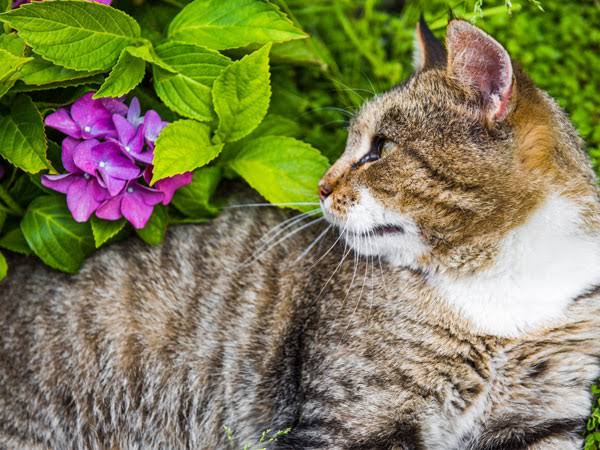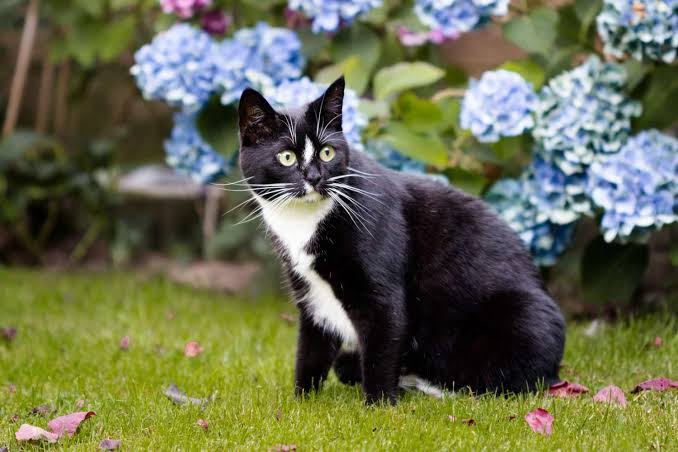Hydrangeas are renowned for their stunning blooms and lush foliage, making them a popular choice for gardens and floral arrangements. However, their beauty hides a potential danger, especially for our feline friends. In this article, we’ll explore the question: are hydrangeas poisonous to cats?
While hydrangeas are not considered highly toxic to humans, they can pose a risk to cats if ingested. The plant contains toxic substances, such as cyanogenic glycosides and amygdalin, which can cause gastrointestinal upset and other symptoms in cats. The severity of the toxicity can vary depending on the species of hydrangea and the parts of the plant ingested.
It’s crucial for cat owners to be aware of the potential risks associated with hydrangeas and to take precautions to keep their pets safe. Recognizing the symptoms of hydrangea poisoning in cats, seeking prompt veterinary care if poisoning is suspected, and implementing preventive measures are key to protecting our feline companions. In the following sections, we’ll delve deeper into the toxic components of hydrangeas, the symptoms of poisoning, treatment options, and practical tips for preventing accidental ingestion by cats. Let’s ensure that our cats can enjoy a safe and healthy environment, free from the dangers of toxic plants like hydrangeas.
Recommended article: List Of Cat Toxic Flowers
Toxic Components in Hydrangeas

Let’s explore the toxic substances found in hydrangeas and how they can affect cats.
1. Cyanogenic Glycosides:
- Hydrangeas contain cyanogenic glycosides, compounds that can release cyanide when metabolized by the body. Cyanide is a potent poison that interferes with cellular respiration, leading to symptoms such as difficulty breathing, seizures, and even death.
- In cats, ingestion of cyanogenic glycosides from hydrangeas can cause gastrointestinal upset, including vomiting, diarrhea, and abdominal pain. Severe cases may result in respiratory distress and neurological symptoms.
2. Amygdalin
- Another toxic compound found in hydrangeas is amygdalin, which is also present in many other plants, including certain fruits and seeds. Amygdalin can break down into cyanide in the body, similar to cyanogenic glycosides, leading to similar toxic effects.
- Cats that ingest amygdalin from hydrangeas may experience symptoms such as drooling, difficulty swallowing, and weakness. Severe cases can lead to respiratory failure and death if not treated promptly.
Toxicity Levels and Variability:
The toxicity levels of hydrangeas can vary depending on the species and parts of the plant ingested. Certain species of hydrangeas, such as Hydrangea macrophylla, are known to contain higher levels of cyanogenic glycosides compared to others.
The flowers, leaves, stems, and roots of hydrangeas all contain varying levels of toxic compounds. Ingestion of any part of the plant can lead to toxicity in cats, with symptoms ranging from mild to severe depending on the amount ingested and the individual cat’s sensitivity.
What To Do If Cat Eats Hydrangeas

If a cat ingests hydrangea and shows signs of poisoning, it is crucial to seek immediate veterinary care. Treatment may include decontamination to remove the plant material from the digestive system, supportive care to address symptoms such as vomiting and diarrhea, and administration of antidotes if necessary.
Prompt veterinary intervention can greatly improve the prognosis for cats exposed to hydrangea toxicity. However, prevention remains the best approach to protect cats from potential harm.
While hydrangeas are prized for their beauty, they can pose a significant risk to cats due to their toxic properties. Understanding the toxic components in hydrangeas and their effects on cats is essential for ensuring the safety of our feline companions. Vigilance, education, and prompt veterinary care are key in protecting cats from the dangers of hydrangea toxicity.
Recommended article: How to Know When a Cat is Pregnant: Symptoms Of Early Pregnancy in Cats
Symptoms of Hydrangea Poisoning in Cats
Hydrangeas are known for their beautiful blooms, but they can pose a danger to cats if ingested. Understanding the symptoms of hydrangea poisoning in cats is crucial for prompt identification and treatment. In this section, we’ll explore the detailed list of symptoms that may indicate hydrangea poisoning in cats and emphasize the importance of seeking veterinary care for suspected cases.
1. Vomiting
- One of the most common symptoms of hydrangea poisoning in cats is vomiting. Cats may vomit shortly after ingesting hydrangea leaves, flowers, or other plant parts.
- The vomiting may be frequent and persistent, leading to dehydration and electrolyte imbalances if not addressed promptly.
2. Diarrhea
- Diarrhea is another hallmark symptom of hydrangea poisoning in cats. The ingestion of toxic compounds in hydrangeas can irritate the gastrointestinal tract, leading to loose or watery stools.
- Cats may experience abdominal discomfort and may strain during bowel movements due to the effects of the toxins on their digestive system.
3. Lethargy
- Cats affected by hydrangea poisoning may exhibit lethargy or weakness. They may appear unusually tired, lack energy, and show a decreased interest in their surroundings or normal activities.
- Lethargy can be a sign of dehydration and an overall decline in health due to the toxic effects of hydrangea ingestion.
4. Difficulty Breathing
- In severe cases of hydrangea poisoning, cats may experience difficulty breathing. This symptom is indicative of a more serious condition and requires immediate veterinary attention.
- Difficulty breathing can be a result of respiratory distress caused by the toxins affecting the cat’s lungs and airways.
5. Other Symptoms
- Additional symptoms of hydrangea poisoning in cats may include drooling, pawing at the mouth, tremors, seizures, and collapse.
- These symptoms indicate a more severe toxicity and should be treated as a medical emergency.
Importance of Veterinary Care
If you suspect that your cat has ingested hydrangea or is showing any of the aforementioned symptoms, it is crucial to seek veterinary care immediately.
Prompt treatment can help mitigate the effects of the toxins, prevent complications, and improve the chances of a positive outcome for your cat.
Being aware of the symptoms of hydrangea poisoning in cats can help you identify and respond to potential cases promptly. If you notice any signs of poisoning, contact your veterinarian immediately for guidance and treatment. Taking swift action can make a significant difference in your cat’s recovery.
Recommended article: The Best Wet Cat Food Dispenser of 2024
Prevention and Safety Measures: Protecting Your Cat from Hydrangea Toxicity
Fortunately, there are several steps you can take to prevent accidental ingestion and keep your feline friend safe. Here are some tips and safety measures to consider:
- Keep Hydrangeas Out of Reach: Place hydrangea plants in areas that are inaccessible to cats, such as high shelves or hanging baskets. This will prevent curious cats from nibbling on the leaves or flowers.
- Use Deterrents: If you have outdoor hydrangea plants, consider using pet-safe deterrents, such as bitter-tasting sprays or natural repellents, to discourage cats from approaching or chewing on the plants.
- Supervise Outdoor Activities: When allowing your cat outdoors, supervise their activities to ensure they do not come into contact with hydrangea plants. Keep an eye on them during walks or outdoor playtime to prevent any accidental ingestion.
- Educate Yourself and Others: Learn to recognize hydrangea plants and educate yourself about the signs of poisoning in cats. Share this information with family members, friends, and pet sitters to ensure everyone is aware of the potential risks.
- Create a Safe Indoor Environment: Provide your cat with a stimulating indoor environment that includes cat-friendly plants that are safe for consumption. This can help satisfy their natural urge to chew on plants without exposing them to toxic species like hydrangeas.
- Seek Veterinary Care: If you suspect your cat has ingested hydrangea or is showing any signs of poisoning, such as vomiting, diarrhea, or lethargy, seek immediate veterinary care. Early intervention is key to a successful outcome.
By taking these preventive measures and being vigilant about your cat’s environment, you can reduce the risk of hydrangea poisoning and ensure a safe and happy environment for your feline companion.
Recommended article: Are Snake Plants Toxic To Cats: See How Snake Plants Can Affect Cats
Frequently Asked Questions About Hydrangeas Poisonous to Cats
1. Are all hydrangeas poisonous to cats?
Yes, all parts of hydrangea plants contain toxins that can be harmful to cats if ingested. The level of toxicity can vary depending on the species and the amount consumed.
2. What are the symptoms of hydrangea poisoning in cats?
Symptoms of hydrangea poisoning in cats may include vomiting, diarrhea, lethargy, drooling, difficulty breathing, and changes in heart rate. In severe cases, it can lead to more serious complications, such as seizures or coma.
3. How much hydrangea is toxic to cats?
The toxicity of hydrangeas to cats can vary depending on factors such as the specific species of hydrangea, the size and weight of the cat, and the amount ingested. Even small amounts of hydrangea can be toxic to cats, so it’s important to seek veterinary care if ingestion is suspected.
4. What should I do if my cat ingests hydrangea?
If you suspect your cat has ingested hydrangea, it’s important to seek veterinary care immediately. Do not attempt to induce vomiting or administer any home remedies without consulting a veterinarian first.
5. How can I prevent my cat from ingesting hydrangea?
To prevent accidental ingestion of hydrangea, keep plants out of reach of cats or use deterrents to discourage them from approaching the plants. Supervise outdoor activities to ensure your cat does not come into contact with hydrangea plants. Educate yourself and others in your household about the potential risks of toxic plants to pets.
Recommended article: Is Rosemary Safe For Cats? Find out if Rosemary is Poisonous to Cats
Conclusion: Keeping Your Cat Safe from Hydrangeas
In conclusion, while hydrangeas are beautiful plants that can enhance your garden or home, they can pose a risk to your feline friends. Understanding the potential dangers of hydrangea poisoning and taking preventive measures can help keep your cat safe and healthy.
Remember to keep hydrangea plants out of reach of cats, use pet-safe deterrents, and supervise outdoor activities to prevent accidental ingestion. Educate yourself and others in your household about the signs of hydrangea poisoning and the importance of seeking veterinary care if ingestion is suspected.
By being proactive and aware of the risks, you can create a safe environment for your cat to thrive. For more tips and articles on pet care, safety, grooming, and products, check our website. Stay informed, stay safe, and keep your furry friends happy and healthy!

